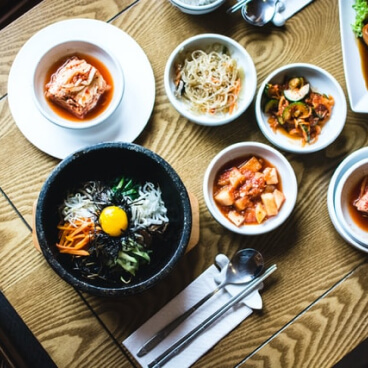Korean cuisine has taken the world by storm with its bold flavors, vibrant colors, and unique combination of sweet, spicy, savory, and umami tastes. If you’re new to Korean food, diving into its iconic dishes is the perfect way to experience this rich culinary tradition. At Momy’s Secret Recipes, we’re here to guide you through this flavorful journey.
Below, we explore seven must-try Korean dishes, complete with cultural insights and helpful tips for first-timers.
1. Kimchi (김치)
Kimchi is the cornerstone of Korean cuisine—a spicy, fermented cabbage that accompanies almost every meal. It’s tangy, spicy, and packed with probiotics, making it both a culinary and health superstar.
- Why It’s Iconic: Kimchi embodies Korea’s traditional fermentation techniques and bold flavors.
- Pro Tip: If you’re a beginner, pair kimchi with rice or mild dishes to balance its intensity.
- Learn More: Discover the science of fermentation on Serious Eats.
2. Bibimbap (비빔밥)
A colorful rice bowl topped with seasoned vegetables, protein (beef, tofu, or egg), and a dollop of spicy gochujang (Korean chili paste). Bibimbap translates to “mixed rice” and is as visually stunning as it is delicious.
- Why It’s Iconic: The dish represents harmony in flavors and nutrition, a key element of Korean cuisine.
- Pro Tip: Stir everything thoroughly to get the perfect balance of flavors.
- Try This at Home: Check out a detailed bibimbap recipe on Korean Bapsang.
3. Bulgogi (불고기)
This sweet and savory marinated beef dish is often grilled or stir-fried. Its tender, flavorful meat is a crowd-pleaser and a fantastic introduction to Korean barbecue.
- Why It’s Iconic: Bulgogi’s marinade—made with soy sauce, sugar, garlic, and sesame oil—is quintessentially Korean.
- Pro Tip: Grill bulgogi on a tabletop barbecue for an authentic experience.
- Learn More: Explore bulgogi variations on Maangchi.
4. Tteokbokki (떡볶이)
This beloved street food features chewy rice cakes simmered in a spicy-sweet sauce made with gochujang and sugar.
- Why It’s Iconic: Tteokbokki is synonymous with Korean street food culture, enjoyed by people of all ages.
- Pro Tip: Balance the heat by pairing it with boiled eggs or fish cakes (odeng).
- Dive In: Discover more street food classics on Korea.net.
5. Samgyeopsal (삼겹살)
Samgyeopsal is thick-cut pork belly grilled at the table and served with ssamjang (a savory dipping sauce) and lettuce wraps.
- Why It’s Iconic: It highlights Korea’s communal dining culture and interactive eating experience.
- Pro Tip: Don’t forget to grill garlic and kimchi alongside the pork for extra flavor.
- Get Inspired: Read about Korean BBQ traditions on Eat Your Kimchi.
6. Sundubu Jjigae (순두부찌개)
A comforting spicy tofu stew made with soft tofu, seafood or meat, and gochugaru (red chili flakes). It’s served bubbling hot and pairs perfectly with steamed rice.
- Why It’s Iconic: This dish showcases Korea’s love for hearty, spicy soups.
- Pro Tip: Crack an egg into the bubbling stew for a creamy addition.
- Cook It: Find an easy sundubu jjigae recipe on Just One Cookbook.
7. Japchae (잡채)
Japchae is a stir-fried noodle dish made with glass noodles (dangmyeon) and a medley of colorful vegetables. It’s sweet, savory, and often served at celebrations.
- Why It’s Iconic: Japchae’s chewy texture and vibrant ingredients make it a festive favorite.
- Pro Tip: Cook the noodles separately to maintain their unique texture.
- Learn How: Try this beginner-friendly recipe on Seonkyoung Longest.
Questions & Answers
1. Is Korean food very spicy?
Not all Korean dishes are spicy! While gochujang and gochugaru are staples, milder dishes like japchae, samgyeopsal, and bibimbap (without chili paste) cater to milder palates.
2. Can I find Korean ingredients easily?
Yes! Many mainstream grocery stores now carry essentials like gochujang, soy sauce, and kimchi. Asian markets or online retailers like HMart offer a wider selection.
3. Are these dishes vegetarian-friendly?
Some dishes like bibimbap and japchae can easily be made vegetarian by swapping meat with tofu or extra veggies. Sundubu jjigae also has vegetarian versions.
4. How can I recreate authentic flavors at home?
Stock up on Korean pantry staples like sesame oil, soy sauce, and gochujang. A rice cooker is also a great investment for perfect rice every time.
5. What’s the best way to enjoy Korean food for the first time?
Start with a Korean BBQ experience to explore the communal dining aspect, then dive into dishes like bibimbap and bulgogi for a taste of tradition.
Final Thoughts
Korean cuisine offers a rich tapestry of flavors and textures, from the spicy kick of kimchi to the comforting warmth of sundubu jjigae. Each dish tells a story of Korea’s culinary heritage, making it a must-try for food lovers.
To explore more beginner-friendly recipes and tips, visit Momy’s Secret Recipes.
For additional insights into Korean culture and food, check out resources like Korean Bapsang and Maangchi.
Which dish will you try first? Let me know in the comments!

